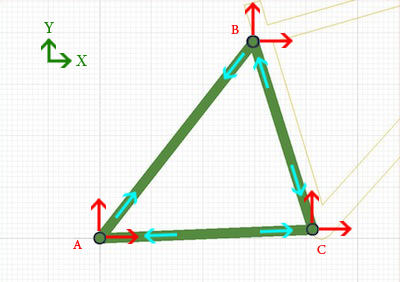Hard Tail
The Hard Tail is the original suspension design: none at all. This is the logical place to start. This design is completely rigid and is the lightest construction technique.  The wheel axle is at point A while points B and C are fixed to the main frame. There is no shock or moving parts, and the axle is static with reference to the main frame.
The wheel axle is at point A while points B and C are fixed to the main frame. There is no shock or moving parts, and the axle is static with reference to the main frame.
For those who are interested in a very light and simple, easy to maintain design, this is the best option out there. There are no moving parts at all, which results in an excellent lateral stiffness. The disadvantage of this is apparent: Any bumps results in a severe loss of rear tire contact with the ground and a rough ride.
The physics of this design is very elementary: Nothing moves! Components AB and BC will be under compression while components BC and AC will be under tension. The input forces at point A will only be in the positive Y direction, since we are only looking at the frame at rest.
The resulting forces on the rest of the frame are as follows: forces at point B will both be in the positive X and Y direction. Point C, near the bottom bracket, there will be both a negative X and Y direction force on the main frame. With looking at the point B as the point of reference for torques, there will be a resultant positive torque on the rear triangle, and thus the whole bike frame (as they are static to each other).
In the past there has been problems with frames (particularly dirt-jump) where the down tube, seat post and chain stay is connected by the bottom bracket shell (Point C), have been under-designed, manufactured incorrectly, or have been the victim of faulty materials. Because all of the frame components attached to the bottom bracket are under high tension, this is a common place of failure among faulty frames.
As a side note: In the past few years this design (along with single speed gearing) has been all the rave with hipsters on college campuses; nobody knows why.
